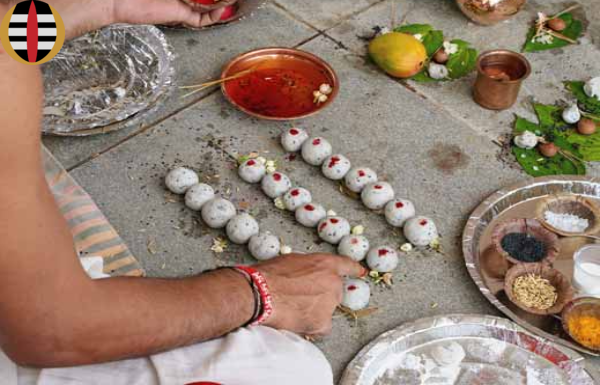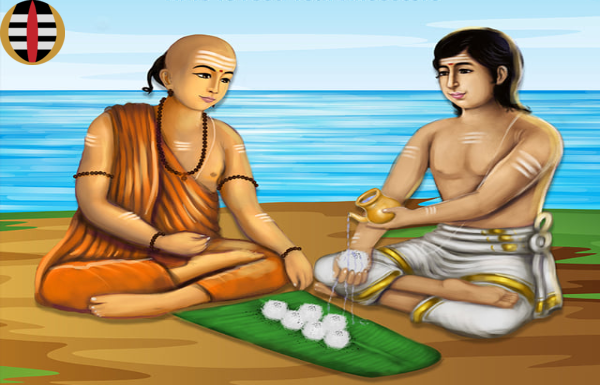Worship of patriarchs
Shraddha Karma
(IPLTOURS)
Hindu mythology describes that human birth is the highest among all births. Human life is fortunate to meditate and worship God by heart, chant and by worship. The experience of love, affection and jealousy is possible only for human beings. Human may bring Moksha to their parents, teacher, relatives and friends by performing rituals and funeral rites in holy places since the God will appear in their forms as believed in general that Matru (Mother) devobhav, Pitru (Father) devobhav, Acharya (Teacher) devobhav and Atidhi (Guest) devobhav. The funeral rites, Dasha Dinakharma (10 days rituals), monthly rites and annuals can perform by the sons, Jamata (daughter’s husband/son-in-law), Dauhitra (daughter’s son/grand son) of the deceased On their availability or a Brahmin and the family of those who performed the rituals can get happiness with their blessings as per legends.
According to Hindu Dharma, death is inevitable to all human beings. Likewise the expired human being will get birth again. It is said that death of the living being is the exit of the invisible soul from the external visible body of the living being. The soul of a deceased being is alive until itŌĆÖs reborn and the soul that has done good deeds is freed and gets absorbed in the Supreme Spirit of the divine world. It has further stated that the living soul who has committed sins during the life time suffers in the hell and cannot be liberated to reach the divine world but wanders between the divine and the earth. It is informed that such souls will be relieved from their pain and get peace through Shraddha Karma by getting liberation besides the persons perform Shraddha Karma will get the blessings of ancestors to their happiness and lineage. Therefore, in the name of the deceased the performer will gift a Cow to get their soul cross the Vaitarini River in hell.┬Ā
In some cases, the last rites of the deceased are performed in the home village, the ten day rituals in a special place and Sraddha Karma on the death day of every month up to twelve months of death along with annuals are performed at home. Some others perform funerals in the village, rituals of third and nineth days along with annuals (Yeti Masikam) at their residence. All the people irrespective of caste perform Pinda Sraddha to the deceased at Kasi (Varanasi), Gaya and Prayag shrines to get the souls of the deceased freed and to attain salvation. All the funeral rites starting from the last rites of those who died due to old age or coincidentally in Varanasi are held in Kashi.┬Ā ┬Ā ┬Ā ┬Ā ┬Ā ┬Ā ┬Ā ┬Ā ┬Ā ┬Ā ┬Ā ┬Ā ┬Ā ┬Ā ┬Ā┬Ā
Legends state that the cremation of the deceased is usually done at a designated place on the bank of a river or a canal and the Shraddha Karma is performed in one’s own home. Among the four castes in Brahmin, Vaisya and Kshatriya, it is common to perform monthly ritual for twelve months on the day on which the deceased passed away to commemorate the elders and all castes perform annual ritual every year on that day.
It is believed that a month on earth is a day for the souls and a year is a day for the souls and on that day they will be happy after seeing the Sraddha karma performed to them. They will bless the offspring and attain the heavenly world. Legend states that it is dharma to perform the main rites of the deceased in their own house. Since there was no such possibility, in the Treta Era, Rama performed Shraddha Karma (rites) to Dasaradh and in Dwapara Era, Balarama to ancestors, Arjuna (brother-in-law) to Lord Krishna, Pandava to Bhishma, Drona, Abhimanyu, Duryodhana, and Karna and other warriers who died in the battle of Kurukshetra in the shrines. It is a Legendy prophecy that a family that does not satisfy their ancestors by worshiping them will not prosper and later will suffer the pains of hell.
Matru Devo Bhav, Pitru Devo Bhav, Acharya Devo Bhav and Atidhi Devo Bhav are literal truths whether it is said in the legends or by elders. It is clear that these are all forms of God. It is the responsibility of the offspring to ensure a better future for them by honoring the birth parents and ancestors by performing Pinda Pradhan. Pinda Pradhan has to be performed at Panch (five) Gaya Shrines are Shiro Gaya (Bihar), Nabhi Gaya (Orissa), Pada Gaya (Andhra Pradesh), Matru Gaya (Siddhapur, Gujarat) and Brahmakapal (Badrinath) which are regarded as Pitru Mukti Kshetra┬Ā for the liberation of the souls of parents and ancestors. In the Himalayas, It is said that Brahmalok will be attained by the ancestors┬Ā for whom pinda pradhan performed at Brahmakapal in Badrinath and those who perform Shraddha Karma in Brahmakapal need not perform Annual ritual. But according to the definition of the prophets, it is said that the souls of the dead will be satisfied by doing Shraddha Karma every year, and if the Karta (performer) performs Shraddha Karma throughout his life, they will be blessed and receive good deeds.
Badari pilgrimage is not a physically feasible activity for all ages. Those who are physically and financially unable to perform pind pradhan in Panch Gaya are advised to do it in Varanasi or Kashi, Gaya and Prayag. It is clear that cremation in Kashi considered to be one of the Seven Moksha Entrances and Pind Pradhan in Kasi, Gaya, Prayaga get the souls freed from the torment of Hell and attain Heaven. Pilgrims from all over the country visit Gaya to offer fetuses to their ancestors during the Pitru Paksha Mela held every year on the banks of the Phalguna River in Gaya. It is estimated that five to seventy lakh pilgrims visit Gaya Shrine in every year during Pitrupaksha to offer Pinda Pradhan to their deceased ancestors. We have elaborated earlier on the need for the embryo to be offered to the ancestors in the Pitru Paksha or Mahalaya Paksha.
Shraddha Karma is considered to be impure and inauspicious as it is associated with death. Shraddha ritual is to be performed by the eldest son or a male relative in three generations of the on the deceased in case of having no sons. The performer should wear a sacred thread or Yajnopaveeth before Pitru Karma. Food offered to ancestors will be placed on a banana leaf. The offering must consist of milk-rice (with sugar/jaggery milk, and rice), cooked rice and dal. The performer of Shraddha Karma should take a bath and wear Dhoti and a ring made of Darbha grass to his right ring finger. The ancestors are invited into the ring. The sacred thread or Yajnopaveeta has to be changed left to right many times during Shraddha Karma. It is so the ritual is performed with bare chest.┬Ā┬Ā┬Ā┬Ā┬Ā┬Ā┬Ā┬Ā┬Ā┬Ā┬Ā┬Ā┬Ā┬Ā┬Ā┬Ā┬Ā┬Ā┬Ā┬Ā┬Ā┬Ā┬Ā┬Ā┬Ā┬Ā┬Ā┬Ā┬Ā┬Ā
Pinda Pradhan is said to be mainly pouring of water through the right index finger on the ball shaped Pind made with cooked rice, ghee and black beans as an offering to the ancestors during the Shraddha ritual. Later Lord Vishnu is worshiped in the form of Darbha grass. If the crow that has been offered the Fetus came and ate the food, it is considered that the ancestral gods have accepted the offering. The role of the crow in Shraddha Karma is supreme. Crows are believed to be the messengers of Lord Yama or the ancestral spirits. cow and dog should be fed to appease the demon. Brahmins are worshiped and food is offered to them. The members of the family ate food only after the feeding to Crows and Brahmins. The performer of the Sraddha and his family members get the blessings of the ancestors in the form of the Brahmins duly satisfying them materially or monetarily.
In today’s daily life, living far away from their parents and due to their work pressure, they are unable to arrange for the last rites and subsequent rituals along with annual rites of their parents, due to lack of time, energy though they financially well settled in their life. Traveling to Kashi became easy due to the availability of several existing train and flight facilities. Brahmins with accommodation and food are available to perform Pinda Pradn and other rituals in Kashi as well as in Gaya and Prayagraj. Hindus believe that the souls of those deceased elders whose bones and ashes are immersed in Ganga┬Ā will reach the holy worlds. According to the Shastra, when the doer (performer of Shraddha Karma) is old or living abroad and cannot perform Shraddha Karma, a Brahmin can be appointed in their place and can be performed the Shraddha Karma and other rituals. At present, there are facilities to watch the program through live video from the place where they are residing due to the technology development.┬Ā





